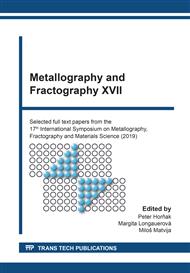p.306
p.312
p.318
p.324
p.333
p.339
p.345
p.351
p.357
Effects on Microstructure and Corrosion Behavior of a Heat Treated CuZn36Pb2 Brass
Abstract:
The brass CuZn36Pb2 is widely used for fittings, valves and other installation materials. Failures are observed occasionally caused by corrosion. Considering the Cu-Zn phase diagram only α-phase exists in the range of 650 and 300 °C. At higher temperatures α- and β-phase is stable and at lower temperatures α- and β´-phase exist. Since the β-phase is Zn-enriches, it is attacked severely by corrosion. In the recent work brass samples were heat treated at temperatures between 850 and 200 °C to study the microstructural changes and the corresponding electrochemical properties. Potentiostatic corrosion tests were applied in artificial fresh water and sea water at different potential settings. After a heat treated at 850 °C the brass has formed b-phase which can be shown by metallography. At lower temperatures the microstructure is fine grained and no β-phase was observed. To verify the presence of β´-phase a heat treatment at 200 °C was performed but no β´-phase was observed, which was confirmed additionally by X-ray diffraction. Again, after corrosion tests the samples were investigated by metallography and the β-phase was obviously more attacked than the α-phase.
Info:
Periodical:
Pages:
333-338
Citation:
Online since:
November 2020
Authors:
Keywords:
Price:
Сopyright:
© 2020 Trans Tech Publications Ltd. All Rights Reserved
Share:
Citation:


